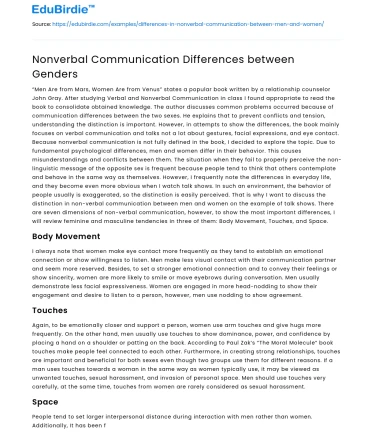Table of contents
- Body Movement
- Touches
- Space
- References
“Men Are from Mars, Women Are from Venus” states a popular book written by a relationship counselor John Gray. After studying Verbal and Nonverbal Communication in class I found appropriate to read the book to consolidate obtained knowledge. The author discusses common problems occurred because of communication differences between the two sexes. He explains that to prevent conflicts and tension, understanding the distinction is important. However, in attempts to show the differences, the book mainly focuses on verbal communication and talks not a lot about gestures, facial expressions, and eye contact. Because nonverbal communication is not fully defined in the book, I decided to explore the topic.
Due to fundamental psychological differences, men and women differ in their behavior. This causes misunderstandings and conflicts between them. The situation when they fail to properly perceive the non-linguistic message of the opposite sex is frequent because people tend to think that others contemplate and behave in the same way as themselves. However, I frequently note the differences in everyday life, and they become even more obvious when I watch talk shows. In such an environment, the behavior of people usually is exaggerated, so the distinction is easily perceived. That is why I want to discuss the distinction in non-verbal communication between men and women on the example of talk shows.
There are seven dimensions of non-verbal communication, however, to show the most important differences, I will review feminine and masculine tendencies in three of them: Body Movement, Touches, and Space.
Body Movement
I always note that women make eye contact more frequently as they tend to establish an emotional connection or show willingness to listen. Men make less visual contact with their communication partner and seem more reserved.
Besides, to set a stronger emotional connection and to convey their feelings or show sincerity, women are more likely to smile or move eyebrows during conversation. Men usually demonstrate less facial expressiveness.
Women are engaged in more head-nodding to show their engagement and desire to listen to a person, however, men use nodding to show agreement.
Touches
Again, to be emotionally closer and support a person, women use arm touches and give hugs more frequently. On the other hand, men usually use touches to show dominance, power, and confidence by placing a hand on a shoulder or patting on the back. According to Paul Zak’s “The Moral Molecule” book touches make people feel connected to each other. Furthermore, in creating strong relationships, touches are important and beneficial for both sexes even though two groups use them for different reasons.
If a man uses touches towards a woman in the same way as women typically use, it may be viewed as unwanted touches, sexual harassment, and invasion of personal space. Men should use touches very carefully, at the same time, touches from women are rarely considered as sexual harassment.
Space
People tend to set larger interpersonal distance during interaction with men rather than women. Additionally, It has been found that women orient more directly to a person during communication showing that they are listening and ready to support.
Men and women have different postures. In the sitting position women usually cross their feet and have a more restricted pose. At the same time, men occupy more space and their poses tend to be more free and expansive.
Understanding nonverbal behavior, which in most cases is unintentional, gives a lot of clues about the emotional state of a person and can be useful to create fulfilling relationships. Even if a person can note the differences, reasons of a specific behavior is still undefined for most people. Exploring the non-linguistic differences between females and males was interesting and useful. As the topic now is much clearer, I believe I will be more effective in preventing conflicts and tension during communication by putting more attention on nonverbal signs.
References
- J. Gray (2002) “Men Are from Mars, Women Are from Venus”
- Marianne LaFrance and Andrea C. Vial (2016) “APA Handbook of Nonverbal Communication”, chapter 6 “Gender and Nonverbal Behavior” https://www.researchgate.net/publication/291330552_Gender_and_Nonverbal_Behavior
- Paul Zak (2013) “The Moral Molecule” https://www.scienceofpeople.com/how-to-read-body-language/
Frequently Asked Questions
In What Way Do Men and Women Typically Differ in Their Use of Space?
Men and women have different postures. In the sitting position women usually cross their feet and have a more restricted pose. At the same time, men occupy more space and their poses tend to be more free and expansive.
What is the Difference Between Men and Women in Terms on Nonverbal Expression?
According to research on nonverbal communication, women learn during childhood to face the other person and use more hand gestures while sitting still. Typically, women’s gestures are more fluid, while men use sharp, directed movements.






 Stuck on your essay?
Stuck on your essay?

